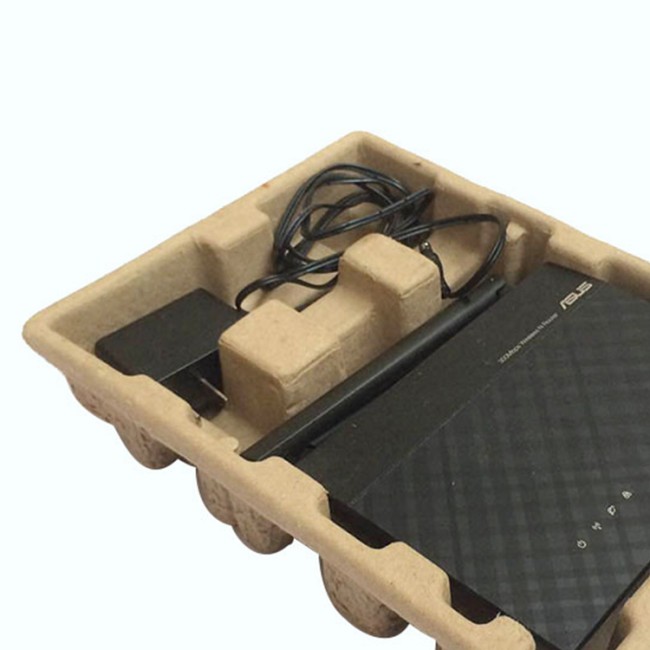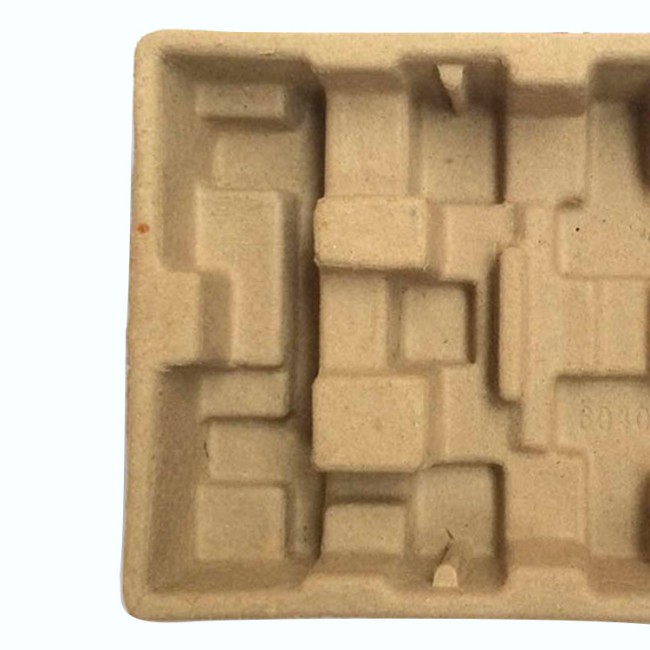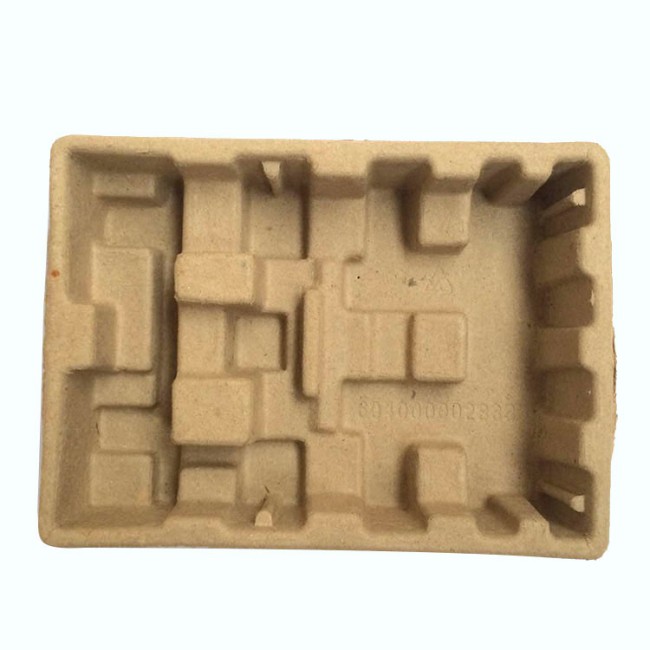As the demand for eco-friendly packaging for electronics continues to rise, more manufacturers are turning to router molded pulp trays as a sustainable and protective alternative to traditional plastic or foam packaging. These trays are designed to provide a tailored fit for network devices like routers, offering durability, shock resistance, and environmental benefits. But what goes into producing a custom molded fiber tray for routers? In this article, we break down the complete manufacturing process behind this innovative and biodegradable molded tray for router applications.

1. Raw Material Selection: Choosing the Right Fiber
The first step in manufacturing any molded pulp packaging is selecting the right raw materials. Router molded pulp trays are typically made from:
-
Recycled paper (such as cardboard, newspaper, or kraft paper)
-
Virgin pulp (for enhanced strength when necessary)
-
Bamboo or sugarcane bagasse (for fully biodegradable solutions)
The selection of raw material depends on the application. Since electronic devices require higher protection, the pulp used for a custom molded fiber tray for router must meet specific strength and density standards. The use of recycled content also supports the overall sustainability goal, making the end product truly eco-friendly packaging for electronics.
2. Pulping Process: Creating a Moldable Slurry
After the raw materials are selected, they go through a pulping process. This involves mixing the paper fibers with water to create a slurry. The pulp is then filtered and refined to achieve the desired consistency and fiber length. In the case of router molded pulp trays, the slurry must be optimized for high-definition molding to ensure precise contours that match the router’s shape. The fiber density and moisture content are carefully controlled to prepare the material for shaping.
3. Mold Design and Engineering: The Key to Customization
A crucial part of producing a custom molded fiber tray for router lies in mold design. This is where precision engineering meets sustainability. The molds are typically made from aluminum or CNC-machined resin and are created based on:
-
The exact dimensions of the router model
-
Required padding or buffer zones for shock absorption
-
Ventilation slots, cable spaces, or other device-specific features
The goal is to create a one-piece router molded pulp tray that fits perfectly inside the outer packaging while securing the router firmly in place.
Custom mold tooling allows manufacturers to create packaging solutions tailored for various router brands and models, ensuring that every tray meets both performance and visual standards.

4. Molding: Shaping the Pulp into Functional Forms
Once the slurry is ready and the mold is engineered, the forming stage begins. There are generally two types of molded pulp forming processes:
-
Wet Press Molding: The wet pulp is shaped directly into the mold, followed by hot pressing to remove moisture and harden the tray.
-
Dry Press Molding: The pulp is first vacuum-formed, then dried in an oven.
For router packaging, wet press molding is often preferred due to its ability to produce smoother surfaces and tighter tolerances. This ensures the biodegradable molded tray for router is not only functional but also aesthetically compatible with premium electronics packaging.
During the molding stage, vacuum pressure is applied to pull the pulp into the mold’s contours. Excess water is removed, and a rough version of the tray begins to take shape.
5. Drying and Curing: Achieving Dimensional Stability
After forming, the trays must be thoroughly dried to remove residual moisture. This step is critical because:
-
Moisture can weaken the tray’s structural integrity
-
Improper drying leads to warping or shrinkage
-
It ensures the tray will maintain its shape inside retail packaging
Depending on the scale of production, manufacturers may use:
-
Continuous belt dryers (for large-scale automation)
-
Batch ovens (for custom or smaller orders)
Temperature and time are precisely controlled to maintain uniform drying and product quality.
6. Trimming and Finishing: Refining the Product
Once dried, the router molded pulp trays move to the trimming stage. Here, excess fiber material is removed using die-cutting or CNC trimming tools. This step ensures a clean and uniform appearance, which is especially important for products that are sold in premium markets.
Finishing touches may include:
-
Embossing brand logos
-
Coating (if moisture resistance is needed)
-
Folding or assembly (for multi-part inserts)
While many pulp trays are left uncoated to remain fully biodegradable, some high-performance electronics packaging may involve a light starch or wax coating for added durability.

7. Quality Control: Ensuring Reliability
Each tray undergoes a final quality inspection to ensure:
-
Accurate dimensions and fit
-
Surface finish meets aesthetic standards
-
No cracks, warping, or fiber inconsistencies
This is essential in maintaining brand trust, especially in the competitive electronics packaging space. A poor-fitting tray could lead to damaged products during transport, while an overly rigid tray might make unboxing difficult.
8. Packaging and Distribution
Finally, the trays are stacked, packaged, and prepared for shipment. Because these trays are designed to nest efficiently, they occupy minimal space, reducing shipping costs and carbon footprint. Many router manufacturers use these trays not just as inner protection but also as part of their brand’s environmental message—highlighting the use of eco-friendly packaging for electronics as a market differentiator.
Why This Process Matters
Understanding the manufacturing process of router molded pulp trays reveals how much engineering, design, and sustainability is involved in what might appear to be a simple packaging insert. The tray’s primary purpose is to protect sensitive electronics, but its environmental impact has become equally important in today’s market. By choosing a biodegradable molded tray for router packaging, brands not only reduce plastic use and waste but also align themselves with a growing global demand for sustainable business practices.
Conclusion:
The journey from recycled fiber to a finished router molded pulp tray is a complex yet rewarding process. From raw material selection to mold design, from forming to quality inspection, every step is tailored to meet the dual needs of product protection and environmental responsibility. For companies seeking to balance protection, branding, and sustainability, the custom molded fiber tray for router is no longer just an option—it’s a competitive necessity. Whether you're a packaging designer, a product manager in the networking industry, or an eco-conscious brand, understanding this process is key to making smarter packaging decisions that benefit both the product and the planet.

